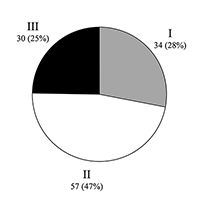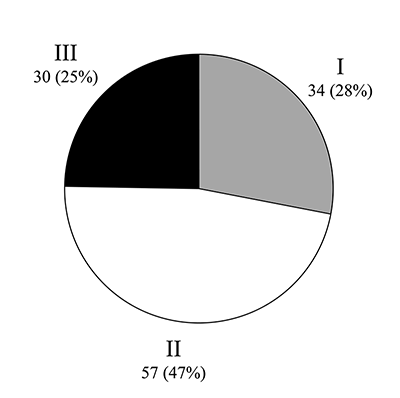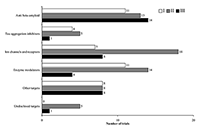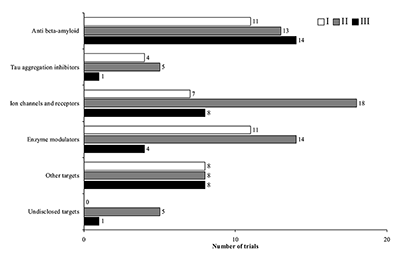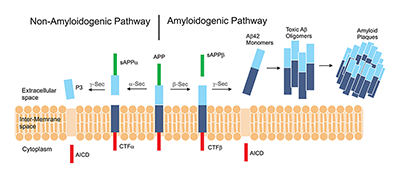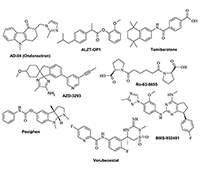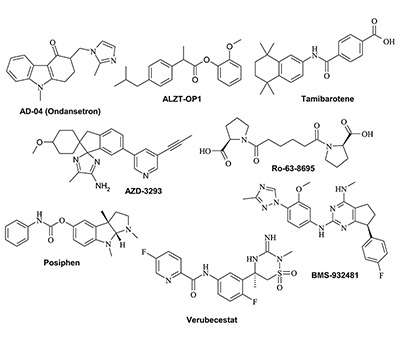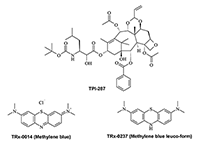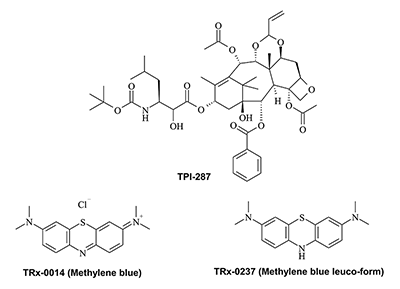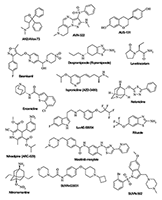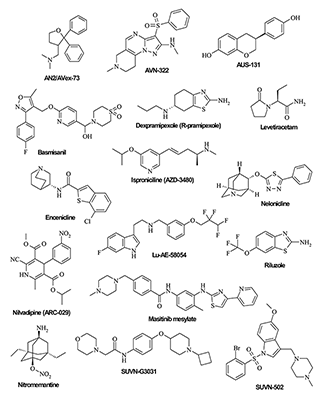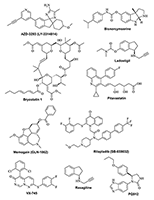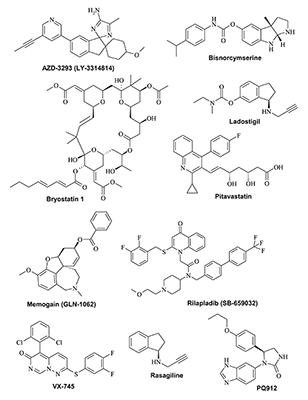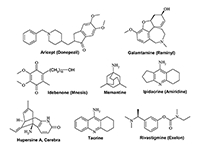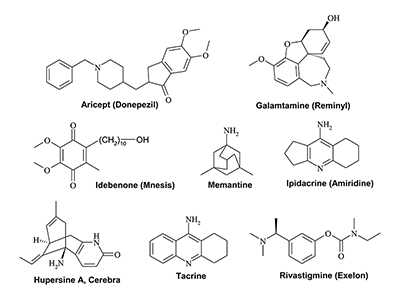The 40th Anniversary of the Institute of Physiologically Active Compounds of the Russian Academy of Sciences
Current Trends in the Development of Drugs for the Treatment of Alzheimer’s Disease
and their Clinical Trials
Institute of Physiologically Active Compounds of the Russian Academy of Sciences, 1 Severny proezd, Moscow region, Chernogolovka, 142432 Russia,*e-mail: bovina_e@ipac.ac.ru
Key words: Alzheimer’s disease; neurodegenerative diseases; multitarget compounds; disease-modifying drugs; repositioning of drugs
DOI: 10.18097/BMCRM00015
Intracellular and extracellular accumulation of fibrillary proteins, beta-amyloid and hyperphosphorylated Tau, in patients with Alzheimer’s disease (AD) leads to chronic and progressive neurodegenerative process. Overaccumulation of aggregates results in synaptic dysfunction and inevitable neuronal loss. Although the exact molecular pathways of the AD still require better understanding, it is clear this neuropathology is a multifactorial disorder where the advanced age is the main risk factor. Lately, several dozens of drug candidates have succeeded to phase II clinical trials; however, none has passed phase III. In this review we summarize existing data on anti-AD therapeutic agents currently undergoing clinical trials and included in the public websites www.clinicaltrials.gov and Alzforum.org as well as the Thomson Reuters «Integrity» database. We revealed three major trends in AD drug discovery. First, developing of “disease-modifying agents” could potentially slow the progression of structural and functional abnormalities in the central nervous system providing sustainable improvements of cognitive functions, which persist even after drug withdrawal. Secondly, the focused design of multitargeted drugs acting on multiple key molecular pathways. Finally, the repositioning of drugs that are already available on the market for the novel (anti-AD) application provides a promising strategy for finishing clinical trials and re-marketing.
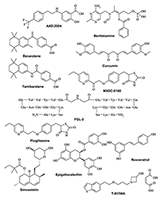
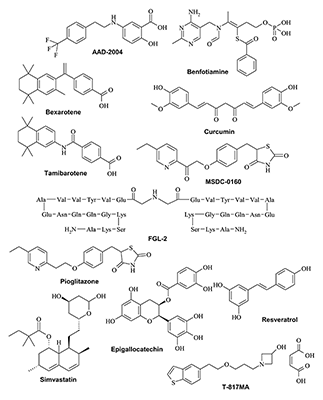
|
Figure 9.
Available structures of other drugs including antioxidants and compounds with undisclosed targets or mechanisms of action.
|
|
CLOSE

|
Table 1.
Agents in phase I clinical trials for AD treatments.
|
|
CLOSE

|
Table 2.
Agents in phase II clinical trials for AD treatments.
|
|
CLOSE

|
Table 3.
Agents in phase III clinical trials for AD treatments.
|
ACKNOWLEDGEMENTS
The study was conducted in accordance to the Research Topic No. 48.8 «The search and determination of the mechanisms of neuroprotectors and stimulators of cognitive functions in the framework of the State Task of the Institute of Physiologically Active Compounds of the Russian Academy of Sciences (Topic: No: 0090-2017-0019).
REFERENCES
- WHO. Dementia. Retrieved December 12, 2017, from: http://www.who.int/news-room/fact-sheets/detail/dementia
- McDade, E. Bateman, R. J. (2017). Stop Alzheimer's before it starts. Nature, 547(7662), 153-155. DOI
- Vademecum. R&D VSEGO SVYATOGO. Retrieved March 23, 2016, from: https://vademec.ru/article/r_d_vsego_svyatogo/
- Kukharsky, M. S., Ovchinnikov, R. K., Bachurin, S. O. (2015). [Molecular aspects of the pathogenesis and current approaches to pharmacological correction of Alzheimer's disease]. Zhurnal nevrologii i psikhiatrii imeni S.S. Korsakova, 115(6), 103-114. DOI
- Nussbaum, J. M., Seward, M. E., Bloom, G. S. (2014). Alzheimer disease: a tale of two prions. Prion, 7(1), 14-19. DOI
- Carreiras, M. C., Mendes, E., Perry, M. J., Francisco, A. P., Marco-Contelles, J. (2013). The multifactorial nature of Alzheimer's disease for developing potential therapeutics. Current Topics in Medicinal Chemistry, 13(15), 1745-1770. DOI
- De-Paula, V. J., Radanovic, M., Diniz, B. S., Forlenza, O. V. (2012). Alzheimer's disease. Subcellular Biochemistry, 65, 329-352. DOI
- Karran, E., Mercken, M., De Strooper, B. (2011). The amyloid cascade hypothesis for Alzheimer's disease: an appraisal for the development of therapeutics. Nature Reviews Drug Discovery, 10(9), 698-712. DOI
- Maccioni, R. B., Farias, G., Morales, I., Navarrete, L. (2010). The revitalized tau hypothesis on Alzheimer's disease. Archives of Medical Research, 41(3), 226-231. DOI
- Sorbi, S. (1993). Molecular genetics of Alzheimer's disease. Aging (Milano), 5(6), 417-425. DOI
- Scheltens, P., Blennow, K., Breteler, M. M., de Strooper, B., Frisoni, G. B., Salloway, S., Van der Flier, W. M. (2016). Alzheimer's disease. Lancet Neurology, 388(10043), 505-517. DOI
- Bradley, W. G. (1990). Alzheimer's disease: theories of causation. Advances in Experimental Medicine and Biology, 282, 31-38. DOI
- Borchelt, D. R., Thinakaran, G., Eckman, C. B., Lee, M. K., Davenport, F., Ratovitsky, T., Prada, C. M., Kim, G., Seekins, S., Yager, D., Slunt, H. H., Wang, R., Seeger, M., Levey, A. I., Gandy, S. E., Copeland, N. G., Jenkins, N. A., Price, D. L., Younkin, S. G., Sisodia, S. S. (1996). Familial Alzheimer's disease-linked presenilin 1 variants elevate Abeta1-42/1-40 ratio in vitro and in vivo. Neuron, 17(5), 1005-1013. DOI
- Chartier-Harlin, M. C., Crawford, F., Hamandi, K., Mullan, M., Goate, A., Hardy, J., Backhovens, H., Martin, J. J., Broeckhoven, C. V. (1991). Screening for the beta-amyloid precursor protein mutation (APP717: Val----Ile) in extended pedigrees with early onset Alzheimer's disease. Neuroscience Letters, 129(1), 134-135. DOI
- Levy-Lahad, E., Wijsman, E. M., Nemens, E., Anderson, L., Goddard, K. A., Weber, J. L., Bird, T. D., Schellenberg, G. D. (1995). A familial Alzheimer's disease locus on chromosome 1. Science, 269(5226), 970-973. PMID: 7638621
- Sisodia, S. S., Kim, S. H., Thinakaran, G. (1999). Function and dysfunction of the presenilins. The American Journal of Human Genetics, 65(1), 7-12. DOI
- Goedert, M., Wischik, C. M., Crowther, R. A., Walker, J. E., Klug, A. (1988). Cloning and sequencing of the cDNA encoding a core protein of the paired helical filament of Alzheimer disease: identification as the microtubule-associated protein tau. Proceedings of the National Academy of Sciences of the United States of America, 85(11), 4051-4055. DOI
- Wischik, C. M., Novak, M., Edwards, P. C., Klug, A., Tichelaar, W., Crowther, R. A. (1988). Structural characterization of the core of the paired helical filament of Alzheimer disease. Proceedings of the National Academy of Sciences of the United States of America, 85(13), 4884-4888. DOI
- Olsson, B., Lautner, R., Andreasson, U., Ohrfelt, A., Portelius, E., Bjerke, M., Holtta, M., Rosen, C., Olsson, C., Strobel, G., Wu, E., Dakin, K., Petzold, M., Blennow, K., Zetterberg, H. (2016). CSF and blood biomarkers for the diagnosis of Alzheimer's disease: a systematic review and meta-analysis. The Lancet Neurology, 15(7), 673-684. DOI
- Glenner, G. G., Wong, C. W., Quaranta, V., Eanes, E. D. (1984). The amyloid deposits in Alzheimer's disease: their nature and pathogenesis. Applied Pathology, 2(6), 357-369. PMID: 6242724
- Selkoe, D. J. (1994). Alzheimer's disease: a central role for amyloid. Journal of Neuropathology and Experimental Neurology, 53(5), 438-447. DOI
- Khlistunova, I., Biernat, J., Wang, Y., Pickhardt, M., von Bergen, M., Gazova, Z., Mandelkow, E., Mandelkow, E. M. (2006). Inducible expression of Tau repeat domain in cell models of tauopathy: aggregation is toxic to cells but can be reversed by inhibitor drugs. The Journal of Biological Chemistry, 281(2), 1205-1214. DOI
- Walsh, D. M. Selkoe, D. J. (2007). A beta oligomers - a decade of discovery. Journal of Neurochemistry, 101(5), 1172-1184. DOI
- Querfurth, H. W. LaFerla, F. M. (2010). Alzheimer's disease. The New England Journal of Medicine, 362(4), 329-344. DOI
- Friedland-Leuner, K., Stockburger, C., Denzer, I., Eckert, G. P., Muller, W. E. (2014). Mitochondrial dysfunction: cause and consequence of Alzheimer's disease. Progress in Molecular Biology and Translational Science, 127, 183-210. DOI
- Raskin, J., Cummings, J., Hardy, J., Schuh, K., Dean, R. A. (2015). Neurobiology of Alzheimer's Disease: Integrated Molecular, Physiological, Anatomical, Biomarker, and Cognitive Dimensions. Current Alzheimer Research, 12(8), 712-722. DOI
- Tipping, K. W., van Oosten-Hawle, P., Hewitt, E. W., Radford, S. E. (2015). Amyloid Fibres: Inert End-Stage Aggregates or Key Players in Disease? Trends in Biochemical Sciences, 40(12), 719-727. DOI
- Iqbal, K., Liu, F., Gong, C. X. (2016). Tau and neurodegenerative disease: the story so far. Nature reviews Neurology, 12(1), 15-27. DOI
- Gavrilova, S. I., Seleznyova, N. D., Roshchina, I. F., Fedorova, Y. B., Rannaya diagnostika bolezni Alzgeimera na dodementnoistadii i preventivnaja terapiya., in Neirodegenerativnye zabolevaniya, Ugryumov, M. V., Editor. 2014, Nauchny Mir: Moskow. p. 95-123.
- Nordberg, A. (2006). Mechanisms behind the neuroprotective actions of cholinesterase inhibitors in Alzheimer disease. Alzheimer Disease and Associated Disorders, 20(2 Suppl 1), S12-18. DOI
- Chalmers, K. A., Wilcock, G. K., Vinters, H. V., Perry, E. K., Perry, R., Ballard, C. G., Love, S. (2009). Cholinesterase inhibitors may increase phosphorylated tau in Alzheimer's disease. Journal of neurology, 256(5), 717-720. DOI
- Danysz, W., Parsons, C. G., Mobius, H. J., Stoffler, A., Quack, G. (2000). Neuroprotective and symptomatological action of memantine relevant for Alzheimer's disease--a unified glutamatergic hypothesis on the mechanism of action. Neurotoxicity Research, 2(2-3), 85-97. DOI
- Danysz, W. Parsons, C. G. (2012). Alzheimer's disease, beta-amyloid, glutamate, NMDA receptors and memantine--searching for the connections. British Journal of Pharmacology, 167(2), 324-352. DOI
- Mohandas, E., Rajmohan, V., Raghunath, B. (2009). Neurobiology of Alzheimer's disease. Indian J Psychiatry, 51(1), 55-61. DOI
- Hemming, M. L. Selkoe, D. J. (2005). Amyloid beta-protein is degraded by cellular angiotensin-converting enzyme (ACE) and elevated by an ACE inhibitor. The Journal of Biological Chemistry, 280(45), 37644-37650. DOI
- Zhang, Y., McLaughlin, R., Goodyer, C., LeBlanc, A. (2002). Selective cytotoxicity of intracellular amyloid beta peptide1-42 through p53 and Bax in cultured primary human neurons. Journal of Cell Biology, 156(3), 519-529. DOI
- Laske, C. (2015). Phase 3 trials of solanezumab and bapineuzumab for Alzheimer's disease. The New England Journal of Medicine, 370(15), 1459. DOI
- Honig, L. S., Vellas, B., Woodward, M., Boada, M., Bullock, R., Borrie, M., Hager, K., Andreasen, N., Scarpini, E., Liu-Seifert, H., Case, M., Dean, R. A., Hake, A., Sundell, K., Hoffmann, V. P., Carlson, C., Khanna, R., Mintun, M., DeMattos, R., Selzler, K. J., Siemers, E. (2018). Trial of Solanezumab for Mild Dementia Due to Alzheimer's Disease. The New England Journal of Medicine, 378(4), 321-330. DOI
- Budd, S. H., O'Gorman, J., Chiao, P., Bussière, T., Tian, Y., Zhu, Y., Gheuens, S., Skordos, L., Chen, T., Sandrock, A. (2017). Clinical Development of Aducanumab, an Anti-Aβ Human Monoclonal Antibody Being Investigated for the Treatment of Early Alzheimer's Disease. The journal of prevention of Alzheimer's disease, 4(4), 255-263. DOI
- Jacobsen, H., Ozmen, L., Caruso, A., Narquizian, R., Hilpert, H., Jacobsen, B., Terwel, D., Tanghe, A., Bohrmann, B. (2014). Combined treatment with a BACE inhibitor and anti-Abeta antibody gantenerumab enhances amyloid reduction in APPLondon mice. Journal of Neuroscience, 34(35), 11621-11630. DOI
- Relkin, N. (2014). Clinical trials of intravenous immunoglobulin for Alzheimer's disease. Journal of Clinical Immunology, 34 Suppl 1, S74-79. DOI
- Relkin, N. R., Szabo, P., Adamiak, B., Burgut, T., Monthe, C., Lent, R. W., Younkin, S., Younkin, L., Schiff, R., Weksler, M. E. (2009). 18-Month study of intravenous immunoglobulin for treatment of mild Alzheimer disease. Neurobiology of Aging, 30(11), 1728-1736. DOI
- Baxalta. Phase III Efficacy, Safety, and Tolerability Study of HYQVIA/HyQvia and GAMMAGARD LIQUID/KIOVIG in CIDP. Retrieved May 18, 2018, from: https://clinicaltrials.gov/ct2/show/NCT02549170
- Liu, E., Schmidt, M. E., Margolin, R., Sperling, R., Koeppe, R., Mason, N. S., Klunk, W. E., Mathis, C. A., Salloway, S., Fox, N. C., Hill, D. L., Les, A. S., Collins, P., Gregg, K. M., Di, J., Lu, Y., Tudor, I. C., Wyman, B. T., Booth, K., Broome, S., Yuen, E., Grundman, M., Brashear, H. R. (2015). Amyloid-beta 11C-PiB-PET imaging results from 2 randomized bapineuzumab phase 3 AD trials. Neurology, 85(8), 692-700. DOI
- Hu, C., Adedokun, O., Ito, K., Raje, S., Lu, M. (2015). Confirmatory population pharmacokinetic analysis for bapineuzumab phase 3 studies in patients with mild to moderate Alzheimer's disease. Journal of Clinical Pharmacology, 55(2), 221-229. DOI
- Jarvis, L. M. (2015). The Next Chapter In Treating Alzheimer's. Chemical and Engineering News. ACS, 93(22), 11-15.
- Schneeberger, A., Mandler, M., Otawa, O., Zauner, W., Mattner, F., Schmidt, W. (2009). Development of AFFITOPE vaccines for Alzheimer's disease (AD)--from concept to clinical testing. The Journal of Nutrition, Health & Aging, 13(3), 264-267. DOI
- PRNewswire. Breakthrough in Alzheimer's Disease: AFFiRiS Halted Clinical Progression in Alzheimer Patients Upon Treatment With AD04 in a Phase II Clinical Study. Retrieved June 04, 2014, from: http://www.prnewswire.com/news-releases/breakthrough-in-alzheimers-disease-affiris-halted-clinical-progression-in-alzheimer-patients-upon-treatment-with-ad04-in-a-phase-ii-clinical-study-261788511.html
- Schneeberger, A., Hendrix, S., Ellison, N., BГјrger, V., Dubois, B. (2015). Results from a phase II study to assess the clinical and immunological activity, safety and tolerability of AFFITOPE AD02 in patients with early Alzheimer's (Abst. 042). in Alzheimer's & Dementia: The Journal of the Alzheimer's Association. Nice, France.
- Hickman, D. T., Lopez-Deber, M. P., Ndao, D. M., Silva, A. B., Nand, D., Pihlgren, M., Giriens, V., Madani, R., St-Pierre, A., Karastaneva, H., Nagel-Steger, L., Willbold, D., Riesner, D., Nicolau, C., Baldus, M., Pfeifer, A., Muhs, A. (2011). Sequence-independent control of peptide conformation in liposomal vaccines for targeting protein misfolding diseases. The Journal of Biological Chemistry, 286(16), 13966-13976. DOI
- Tucker, S., Moller, C., Tegerstedt, K., Lord, A., Laudon, H., Sjodahl, J., Soderberg, L., Spens, E., Sahlin, C., Waara, E. R., Satlin, A., Gellerfors, P., Osswald, G., Lannfelt, L. (2015). The murine version of BAN2401 (mAb158) selectively reduces amyloid-beta protofibrils in brain and cerebrospinal fluid of tg-ArcSwe mice. Journal of Alzheimer's Disease, 43(2), 575-588. DOI
- Wang, C. Y., Finstad, C. L., Walfield, A. M., Sia, C., Sokoll, K. K., Chang, T. Y., Fang, X. D., Hung, C. H., Hutter-Paier, B., Windisch, M. (2007). Site-specific UBITh amyloid-beta vaccine for immunotherapy of Alzheimer's disease. Vaccine, 25(16), 3041-3052. DOI
- UnitedNeuroscienceLtd. Evaluate the Safety, Tolerability, Immunogenicity and Efficacy of UB-311 in Mild Alzheimer's Disease (AD) Patients. Retrieved April 11, 2018, from: https://clinicaltrials.gov/ct2/show/NCT02551809
- Adolfsson, O., Pihlgren, M., Toni, N., Varisco, Y., Buccarello, A. L., Antoniello, K., Lohmann, S., Piorkowska, K., Gafner, V., Atwal, J. K., Maloney, J., Chen, M., Gogineni, A., Weimer, R. M., Mortensen, D. L., Friesenhahn, M., Ho, C., Paul, R., Pfeifer, A., Muhs, A., Watts, R. J. (2012). An effector-reduced anti-beta-amyloid (Abeta) antibody with unique abeta binding properties promotes neuroprotection and glial engulfment of Abeta. Journal of Neuroscience, 32(28), 9677-9689. DOI
- Landen, J. W., Zhao, Q., Cohen, S., Borrie, M., Woodward, M., Billing, C. B., Jr., Bales, K., Alvey, C., McCush, F., Yang, J., Kupiec, J. W., Bednar, M. M. (2013). Safety and pharmacology of a single intravenous dose of ponezumab in subjects with mild-to-moderate Alzheimer disease: a phase I, randomized, placebo-controlled, double-blind, dose-escalation study. Clinical Neuropharmacology, 36(1), 14-23. DOI
- Dodel, R., Rominger, A., Blennow, K., Barkhof, F., Wietek, S., Haag, S., Bartenstein, P., Farlow, M., Jessen, F. (2011). A randomized, double-blind, placebo-controlled dose-finding trial of intravenous immunoglobulin (IVIG; Octagam® 10%,Octapharma AG) in patients with mild to moderate Alzheimer's disease (GAM10-04). Alzheimer's & Dementia: The Journal of the Alzheimer's Association, 7(4), e55-e56. DOI
- Pradier, L., Cohen, C., Blanchard, V., Debeir, T., Barneoud, P., Canton, T., Menager, J., Bohme, A., Rooney, T., Guillet, M., Cameron, B., Shi, Y., Naimi, S., Ravetch, J., Claudel, S., Alam, J. (2013). SAR228810: An antiprotofibrillar beta-amyloid antibody designed to reduce risk of amyloid-related imaging abnormalities (ARIA). Alzheimer's & Dementia: The Journal of the Alzheimer's Association, 9(4), P808-P809. DOI
- Rosen, L., Pomfret, M., Billinton, A., Chessell, I., Chessell, T., Kugler, A., Lindqvist, E., McFarlane, M., Groves, M., Narwal, R., Tan, K., Tatipalli, M., Dudley, A. (2015). Tolerability and preliminary pharmacodynamics after single doses of MEDI1814, a Beta-Amyloid 42 (Aß42)-specific antibody, in mild-moderate Alzheimer's disease. In 8th Clinical Trials Alzheimer's Disease (CTAD) Confernce Abst. #OC25. Barcelona: The Journal of Prevention of Alzheimer's Disease.
- KHK Pharma. A Study of Single and Multiple Doses of KHK6640 in Subjects With Prodromal or Mild to Moderate Alzheimer's Disease. Retrieved February 03, 2014, from: https://clinicaltrials.gov/ct2/show/study/NCT02127476
- Davtyan, H., Ghochikyan, A., Petrushina, I., Hovakimyan, A., Davtyan, A., Poghosyan, A., Marleau, A. M., Movsesyan, N., Kiyatkin, A., Rasool, S., Larsen, A. K., Madsen, P. J., Wegener, K. M., Ditlevsen, D. K., Cribbs, D. H., Pedersen, L. O., Agadjanyan, M. G. (2013). Immunogenicity, efficacy, safety, and mechanism of action of epitope vaccine (Lu AF20513) for Alzheimer's disease: prelude to a clinical trial. Journal of Neuroscience, 33(11), 4923-4934. DOI
- Zhou, B., Rothlein, R., Shen, J., Valcarce, C., Selmer, J., Hanhan, M., Kindy, M., Mjalli, A., Kostura, M. (2013). TTP4000, a soluble fusion protein inhibitor of receptor for advanced glycation end products (RAGE) is an effective therapy in animal models of Alzheimer's disease. in Experimental Biology. Boston, USA.
- Yan, R. Vassar, R. (2014). Targeting the beta secretase BACE1 for Alzheimer's disease therapy. The Lancet Neurology, 13(3), 319-329. DOI
- Alexander, R., Haeberlein, S., Rosen, L. (2015). AZD3293 a novel BACE1 inhibitor: Pharmacokinetics and effects on plasma and CSF A-beta peptides following multiple-dose administration in Alzheimer's disease patients (Abst. 091). 12th International Conference on Alzheimer's and Parkinson's Disease (AD/PD). Nice, France.
- Neumann, U., Rueeger, H., Machauer, R., Veenstra, S. J., Lueoend, R. M., Tintelnot-Blomley, M., Laue, G., Beltz, K., Vogg, B., Schmid, P., Frieauff, W., Shimshek, D. R., Staufenbiel, M., Jacobson, L. H. (2015). A novel BACE inhibitor NB-360 shows a superior pharmacological profile and robust reduction of amyloid-beta and neuroinflammation in APP transgenic mice. Molecular Neurodegeneration, 10, 44. DOI
- Matijevic, M., Watanabe, H., Sato, Y., Bernier, F., McGrath, S., Burns, L., Yamamoto, N., Ogo, M., Dezso, Z., Chow, J., Oda, Y., Kaplow, J., Albala, B. (2015). A single dose of the beta-secretase inhibitor, e2609, decreases CSF bace1 enzymatic activity in cynomolgus monkeys. Alzheimer's & Dementia: The Journal of the Alzheimer's Association, 11(7), P841. DOI
- Nicolas, L., Kammerer, K.-P., Schaible, J., Link, J., Kleiner, O., Borta, A., Podhorna, J., Scholpp, J. (2015). Pharmacokinetics, pharmacodynamics, and safety of the novel bace inhibitor bi1181181 after oral administration of single ascending doses in healthy subjects. Alzheimer's & Dementia: The Journal of the Alzheimer's Association, 11(7), P740-P741. DOI
- FORUMPharmaceuticals. Safety, Tolerability, Pharmacokinetics of EVP-0962 and Effects of EVP-0962 on Cerebral Spinal Fluid Amyloid Concentrations in Healthy Subjects and in Subjects With Mild Cognitive Impairment or Early Alzheimer's Disease. Retrieved January 13, 2014, from: https://clinicaltrials.gov/ct2/show/NCT01661673
- Navarro, D., Castaner, R., Fernandez-Forner, D. (2015). NME digest. Drugs on the Future, 40(10), 667.
- Panza, F., Seripa, D., Solfrizzi, V., Imbimbo, B. P., Lozupone, M., Leo, A., Sardone, R., Gagliardi, G., Lofano, L., Creanza, B. C., Bisceglia, P., Daniele, A., Bellomo, A., Greco, A., Logroscino, G. (2016). Emerging drugs to reduce abnormal beta-amyloid protein in Alzheimer's disease patients. Expert Opinion on Emerging Drugs, 21(4), 377-391. DOI
- ShanghaiGreenvalleyPharmaceutical. Safety, Efficacy and Dose Titration of Sodium Oligo-mannurarate Capsule on Mild to Moderate Alzheimer's Disease. Retrieved January 27, 2015, from: https://clinicaltrials.gov/ct2/show/NCT01453569
- Maccecchini, M. L., Chang, M. Y., Pan, C., John, V., Zetterberg, H., Greig, N. H. (2012). Posiphen as a candidate drug to lower CSF amyloid precursor protein, amyloid-beta peptide and tau levels: target engagement, tolerability and pharmacokinetics in humans. Journal of Neurology, Neurosurgery and Psychiatry, 83(9), 894-902. DOI
- Sinha, S., Du, Z., Maiti, P., Klarner, F. G., Schrader, T., Wang, C., Bitan, G. (2012). Comparison of three amyloid assembly inhibitors: the sugar scyllo-inositol, the polyphenol epigallocatechin gallate, and the molecular tweezer CLR01. ACS Chemical Neuroscience, 3(6), 451-458. DOI
- Transition Therapeutics. Transition Therapeutics Announces Results of Data Analysis from ELND005 Phase 2/3 Clinical Study in Agitation and Aggression in Alzheimer's Disease Patients. Retrieved May 03, 2018, from: https://www.prnewswire.com/news-releases/transition-therapeutics-announces-results-of-data-analysis-from-elnd005-phase-23-clinical-study-in-agitation-and-aggression-in-alzheimers-disease-patients-533007951.html
- Pepys, M. B., Herbert, J., Hutchinson, W. L., Tennent, G. A., Lachmann, H. J., Gallimore, J. R., Lovat, L. B., Bartfai, T., Alanine, A., Hertel, C., Hoffmann, T., Jakob-Roetne, R., Norcross, R. D., Kemp, J. A., Yamamura, K., Suzuki, M., Taylor, G. W., Murray, S., Thompson, D., Purvis, A., Kolstoe, S., Wood, S. P., Hawkins, P. N. (2002). Targeted pharmacological depletion of serum amyloid P component for treatment of human amyloidosis. Nature, 417(6886), 254-259. DOI
- Suhr, O. B., Lundgren, E., Westermark, P. (2010). Transthyretin amyloidoses: New strategies for therapeutic intervention. Drugs on the Future, 35(4), 325. DOI
- BELLUS. BELLUS Health Announces Partnership for the Development of BLU8499. Retrieved September 04, 2012, from: http://www.bellushealth.com/English/investors-and-news/press-releases/press-release-details/2012/BELLUS-Health-Announces-Partnership-for-the-Development-of-BLU84991130839/default.aspx
- Vartiainen, N. E., Williams, M., Charles, M. L., Stenius, T., Nurmi, A., Yrjanheikki, J. (2009). SAN-61 protects against Ab1-42, OGD and H2O2 in rat mixed cortical cultures and inhibits GSK-3b (Abst. 336.16/L15). in 39th Society for Neuroscience Meeting. Chicago.
- Hu, Q., Cam, J., Lake, T., Cummings, J., Esposito, L., Yadon, M.-C., Snow, A. Identification of Exebryl-1 and other novel small molecules as tau protein aggregation inhibitors. in Alzheimer's & Dementia: The Journal of the Alzheimer's Association. Abst #P2-529. 2011. DOI
- Brunden, K. R., Trojanowski, J. Q., Lee, V. M. (2009). Advances in tau-focused drug discovery for Alzheimer's disease and related tauopathies. Nature Reviews Drug Discovery, 8(10), 783-793. DOI
- Valera, E., Spencer, B., Masliah, E. (2016). Immunotherapeutic Approaches Targeting Amyloid-beta, alpha-Synuclein, and Tau for the Treatment of Neurodegenerative Disorders. Neurotherapeutics, 13(1), 179-189. DOI
- Novak, M. (2009). Tau vaccine: Active immunization with misfolded tau protein attenuates tau pathology in the transgenic rat model of tauopathy. in Alzheimer's Association International Conference on Alzheimer's Disease (Abst S2-01-02). Vienna, Austria: Alzheimer's & Dementia.
- Sheridan, C. (2015). Pivotal trials for beta-secretase inhibitors in Alzheimer's. Nature Biotechnology, 33(2), 115-116. DOI
- Riedmann, E. M. (2014). Swiss biotech firm starts first trial of a tau-targeting Alzheimer vaccine. Human Vaccines & Immunotherapeutics, 10(3), 531. DOI
- Bristol-MyersSquibb. A Randomized, Double-Blind, Placebo-Controlled, Single Ascending Dose Study of Intravenously Administered BMS-986168 in Healthy Subjects. Retrieved November 06, 2017, from: https://clinicaltrials.gov/ct2/show/NCT02294851
- Wischik, C. M., Edwards, P. C., Lai, R. Y., Roth, M., Harrington, C. R. (1996). Selective inhibition of Alzheimer disease-like tau aggregation by phenothiazines. Proceedings of the National Academy of Sciences of the United States of America, 93(20), 11213-11218. DOI
- Wischik, C. M., Staff, R. T., Wischik, D. J., Bentham, P., Murray, A. D., Storey, J. M., Kook, K. A., Harrington, C. R. (2015). Tau aggregation inhibitor therapy: an exploratory phase 2 study in mild or moderate Alzheimer's disease. Journal of Alzheimer's Disease, 44(2), 705-720. DOI
- Fox, P. Cognitive and Functional Connectivity Effects of Methylene Blue in Healthy Aging, Mild Cognitive Impairment and Alzheimer's Disease (MB2). Retrieved January 05, 2018, from: https://clinicaltrials.gov/ct2/show/NCT02380573
- Baddeley, T. C., McCaffrey, J., Storey, J. M., Cheung, J. K., Melis, V., Horsley, D., Harrington, C. R., Wischik, C. M. (2015). Complex disposition of methylthioninium redox forms determines efficacy in tau aggregation inhibitor therapy for Alzheimer's disease. Journal of Pharmacology and Experimental Therapeutics, 352(1), 110-118. DOI
- Panza, F., Solfrizzi, V., Seripa, D., Imbimbo, B. P., Lozupone, M., Santamato, A., Zecca, C., Barulli, M. R., Bellomo, A., Pilotto, A., Daniele, A., Greco, A., Logroscino, G. (2016). Tau-Centric Targets and Drugs in Clinical Development for the Treatment of Alzheimer's Disease. BioMed Research International, 2016, 15. DOI
- Muggia, F. Kudlowitz, D. (2014). Novel taxanes. Anticancer Drugs, 25(5), 593-598. DOI
- Ramirez, M. J., Lai, M. K., Tordera, R. M., Francis, P. T. (2014). Serotonergic therapies for cognitive symptoms in Alzheimer's disease: rationale and current status. Drugs, 74(7), 729-736. DOI
- Wilkinson, D., Windfeld, K., Colding-Jorgensen, E. (2014). Safety and efficacy of idalopirdine, a 5-HT6 receptor antagonist, in patients with moderate Alzheimer's disease (LADDER): a randomised, double-blind, placebo-controlled phase 2 trial. The Lancet Neurology, 13(11), 1092-1099. DOI
- Maher-Edwards, G., Dixon, R., Hunter, J., Gold, M., Hopton, G., Jacobs, G., Hunter, J., Williams, P. (2011). SB-742457 and donepezil in Alzheimer disease: a randomized, placebo-controlled study. International Journal of Geriatric Psychiatry, 26(5), 536-544. DOI
- Daripelli, S., Bhyrapuneni, G., Mudigonda, K., Benade, V., Ayyanki, G., Kamuju, V., Ponnamaneni, R., Manoharan, A., Nirogi, R. (2015). Novel 5-HT6 antagonist, SUVN-502 potentiates the effects of donepezil on neurochemical and electrophysiological activity in rat hippocampus (Abst. 761.11). In 45th Annual Meeting Society for Neuroscience. Chicago, USA.
- Tkachenko, S., Ivachtchenko, A., Khvat, A., Okun, I., Lavrovsky, Y., Salimov, R. (2009). Discovery and preclinical studies of AVN-322 highly selective and potent 5HT6 antagonist for cognition enhancement in treating neurodegerative diseases. In 9th International Conference Alzheimer's and Parkinson Disease (AD/PD).
- Kwon, S., Rajagopal, L., Huang, M., Michael, E., Meltzer, H. (2015). RP5063 reverses and prevents sub-chronic phencyclidine-induced declarative memory deficits and increased dopamine efflux in the prefrontal cortex region in C57BL/6J mice (Abst/823.04). in 45th Annual Meeting Society for Neuroscience. Chicago, USA.
- Thomsen, M. S., Andreasen, J. T., Arvaniti, M., Kohlmeier, K. A. (2016). Nicotinic Acetylcholine Receptors in the Pathophysiology of Al zheimer's Disease: The Role of Protein-Protein Interactions in Current and Future Treatment. Current Pharmaceutical Design, 22(14), 2015-2034. DOI
- Lombardo, S. Maskos, U. (2013). Role of the nicotinic acetylcholine receptor in Alzheimer's disease pathology and treatment. Neuropharmacology, 96(Pt B), 255-262. DOI
- Othman, A., Meier, A., Ritchie, C. W., Florian, H., Gault, L. M., Tang, Q. (2014). Efficacy and safety of the alpha7 agonist abt-126 as a monotherapy treatment in mild-to-moderate alzheimer's dementia: results of a phase 2b trial. Alzheimer's & Dementia: The Journal of the Alzheimer's Association, 10(4), P137. DOI
- Frolich, L., Ashwood, T., Nilsson, J., Eckerwall, G. (2011). Effects of AZD3480 on cognition in patients with mild-to-moderate Alzheimer's disease: a phase IIb dose-finding study. Journal of Alzheimer's Disease, 24(2), 363-374. DOI
- Greenamyre, J. T., Maragos, W. F., Albin, R. L., Penney, J. B., Young, A. B. (1988). Glutamate transmission and toxicity in Alzheimer's disease. Progress in Neuro-psychopharmacology & Biological Psychiatry, 12(4), 421-430. DOI
- Nakamura, T. Lipton, S. A. (2016). Protein S-Nitrosylation as a Therapeutic Target for Neurodegenerative Diseases. Trends in Pharmacological Sciences, 37(1), 73-84. DOI
- Avanir. Avanir Pharmaceuticals Announces Initiation of Phase II Study of AVP-786 for the Adjunctive Treatment of Major Depressive Disorder. Retrieved August 26, 2014, from: http://www.prnewswire.com/news-releases/avanir-pharmaceuticals-announces-initiation-of-phase-ii-study-of-avp-786-for-the-adjunctive-treatment-of-major-depressive-disorder-272700931.html
- Chumakov, I., Nabirotchkin, S., Cholet, N., Milet, A., Boucard, A., Toulorge, D., Pereira, Y., Graudens, E., Traore, S., Foucquier, J., Guedj, M., Vial, E., Callizot, N., Steinschneider, R., Maurice, T., Bertrand, V., Scart-Gres, C., Hajj, R., Cohen, D. (2015). Combining two repurposed drugs as a promising approach for Alzheimer's disease therapy. Scientific Reports, 5, 7608. DOI
- Lin, C. H., Chen, P. K., Chang, Y. C., Chuo, L. J., Chen, Y. S., Tsai, G. E., Lane, H. Y. (2014). Benzoate, a D-amino acid oxidase inhibitor, for the treatment of early-phase Alzheimer disease: a randomized, double-blind, placebo-controlled trial. Biological Psychiatry, 75(9), 678-685. DOI
- Grigoriev, V. V., Proshin, A. N., Kinzirsky, A. S., Bachurin, S. (2009). Modern approaches to the design of memory and cognitive function stimulants based on AMPA receptor ligands. Russian Chemical Reviews, 78(5), 485. DOI
- Louis, C., Danober, L., Carrié, I., Dumas, N., Albinet, K., Llopis, K., Roger, A., Gandon, M.-H., Hugot, A., Krentner, M., Thomas, J.-Y., Rogez, N., Vandesquille, M., Krazem, A., Béracochéa, D., Bertainaanglade, V., Drieu la rochelle, C., Junges, C., Bertrand, M., Billiald, S., Tordjman, C., Cordi, A., Lestage, P. (2015). In vivo pharmacological profile of S47445, a novel positive allosteric modulator of AMPA-type glutamate receptors (Abst. 365). in 12th International Conference on Alzheimer's and Parkinson's Disease (AD/PD). Nice, France.
- Mandavilli, A. (2006). The amyloid code. Nature Medicine, 12(7), 747-751. DOI
- Piette, F., Belmin, J., Vincent, H., Schmidt, N., Pariel, S., Verny, M., Marquis, C., Mely, J., Hugonot-Diener, L., Kinet, J. P., Dubreuil, P., Moussy, A., Hermine, O. (2011). Masitinib as an adjunct therapy for mild-to-moderate Alzheimer's disease: a randomised, placebo-controlled phase 2 trial. Alzheimer's research & therapy, 3(2), 16. DOI
- Lawlor, B., Kennelly, S., O'Dwyer, S., Cregg, F., Walsh, C., Coen, R., Kenny, R. A., Howard, R., Murphy, C., Adams, J., Daly, L., Segurado, R., Gaynor, S., Crawford, F., Mullan, M., Lucca, U., Banzi, R., Pasquier, F., Breuilh, L., Riepe, M., Kalman, J., Wallin, A., Borjesson, A., Molloy, W., Tsolaki, M., Olde Rikkert, M. (2014). NILVAD protocol: a European multicentre double-blind placebo-controlled trial of nilvadipine in mild-to-moderate Alzheimer's disease. BMJ Open, 4(10). DOI
- Ferguson, S., Bishop, A., Mouzon, B., Phillips, J., Crynen, G., Reed, J., Chaytow, H., Mullan, M., Mathura, V., Mullan, M., Crawford, F. (2011). Time course of inflammatory marker response after TBI (Abst #254.07/Z8). in 41th Annual Meeting Society for Neuroscience. Washington, D.C.
- Sadek, B., Saad, A., Sadeq, A., Jalal, F., Stark, H. (2016). Histamine H3 receptor as a potential target for cognitive symptoms in neuropsychiatric diseases. Behavioural Brain Research, 312, 415-430. DOI
- Panayi, F., Sors, A., Bert, L. (2015). Mechanistic characterization of S 38093, a novel inverse agonist at histamine H3 receptors (Abst. 156). in 12th International Conference on Alzheimer's and Parkinson's Disease (AD/PD). Nice, France.
- Benade, V. S., Daripelli, S., Thentu, J. B., Manoharan, A., Medapati, R. B., Subramanian, R., Mekala, V. R., Shinde, A. K., Badange, R. K., Goyal, V. K., Pandey, S. K., Nirogi, R. (2015). SUVN-G3031, a H3 receptor inverse agonist produces procognitive effects without affecting sleep in preclinical models. Alzheimer's & Dementia: The Journal of the Alzheimer's Association, 11(7), P475. DOI
- Yao, J., Zhao, L., Mao, Z., Chen, S., Wong, K. C., To, J., Brinton, R. D. (2013). Potentiation of brain mitochondrial function by S-equol and R/S-equol estrogen receptor beta-selective phytoSERM treatments. Brain Research, 1514, 128-141. DOI
- Rinne, J. O., Wesnes, K., Hänninen, J., Murphy, M., Riordan, H., Rouru, J., Group, A. S. (2013). Safety and efficacy of ORM-12741 on cognitive and behavioral symptoms in patients with Alzheimer's disease: A randomized, double-blind, proof-of-concept study. Journal of the Neurological Sciences, 333, e322. DOI
- Lahmy, V., Meunier, J., Malmstrom, S., Naert, G., Givalois, L., Kim, S. H., Villard, V., Vamvakides, A., Maurice, T. (2013). Blockade of Tau hyperphosphorylation and Abeta(1)(-)(4)(2) generation by the aminotetrahydrofuran derivative ANAVEX2-73, a mixed muscarinic and sigma(1) receptor agonist, in a nontransgenic mouse model of Alzheimer's disease. Neuropsychopharmacology, 38(9), 1706-1723. DOI
- Cudkowicz, M., Bozik, M. E., Ingersoll, E. W., Miller, R., Mitsumoto, H., Shefner, J., Moore, D. H., Schoenfeld, D., Mather, J. L., Archibald, D., Sullivan, M., Amburgey, C., Moritz, J., Gribkoff, V. K. (2011). The effects of dexpramipexole (KNS-760704) in individuals with amyotrophic lateral sclerosis. Nature Medicine, 17(12), 1652-1656. DOI
- Chiu, W. H., Depboylu, C., Hermanns, G., Maurer, L., Windolph, A., Oertel, W. H., Ries, V., Hoglinger, G. U. (2015). Long-term treatment with L-DOPA or pramipexole affects adult neurogenesis and corresponding non-motor behavior in a mouse model of Parkinson's disease. Neuropharmacology, 95, 367-376. DOI
- Sanchez, P. E., Zhu, L., Verret, L., Vossel, K. A., Orr, A. G., Cirrito, J. R., Devidze, N., Ho, K., Yu, G. Q., Palop, J. J., Mucke, L. (2012). Levetiracetam suppresses neuronal network dysfunction and reverses synaptic and cognitive deficits in an Alzheimer's disease model. Proceedings of the National Academy of Sciences of the United States of America, 109(42), E2895-2903. DOI
- Xiao, R. (2016). Levetiracetam might act as an efficacious drug to attenuate cognitive deficits of Alzheimer's disease. Current Topics in Medicinal Chemistry, 16(5), 565-573. DOI
- Hunsberger, H. C., Weitzner, D. S., Rudy, C. C., Hickman, J. E., Libell, E. M., Speer, R. R., Gerhardt, G. A., Reed, M. N. (2015). Riluzole rescues glutamate alterations, cognitive deficits, and tau pathology associated with P301L tau expression. Journal of Neurochemistry, 135(2), 381-394. DOI
- Sugiyama, A., Saitoh, A., Inagaki, M., Oka, J., Yamada, M. (2015). Systemic administration of riluzole enhances recognition memory and facilitates extinction of fear memory in rats. Neuropharmacology, 97, 322-328. DOI
- Blasco, H., Mavel, S., Corcia, P., Gordon, P. H. (2014). The glutamate hypothesis in ALS: pathophysiology and drug development. Current Medicinal Chemistry, 21(31), 3551-3575. DOI
- Giacobini, E. (1994). Therapy of Alzheimer disease: symptomatic or neuroprotective? Journal of Neural Transmission. Supplementa, 43, 211-217. PMID: 7884402
- Knapp, M. J., Knopman, D. S., Solomon, P. R., Pendlebury, W. W., Davis, C. S., Gracon, S. I. (1994). A 30-week randomized controlled trial of high-dose tacrine in patients with Alzheimer's disease. The Tacrine Study Group. Journal of the American Medical Association, 271(13), 985-991. DOI
- Lane, R. M. He, Y. (2013). Butyrylcholinesterase genotype and gender influence Alzheimer's disease phenotype. Alzheimer's & Dementia: Translational Research & Clinical Interventions, 9(2), e1-73. DOI
- Furukawa-Hibi, Y., Alkam, T., Nitta, A., Matsuyama, A., Mizoguchi, H., Suzuki, K., Moussaoui, S., Yu, Q. S., Greig, N. H., Nagai, T., Yamada, K. (2011). Butyrylcholinesterase inhibitors ameliorate cognitive dysfunction induced by amyloid-beta peptide in mice. Behavioural Brain Research, 225(1), 222-229. DOI
- Inestrosa, N. C., Dinamarca, M. C., Alvarez, A. (2008). Amyloid-cholinesterase interactions. Implications for Alzheimer's disease. The FEBS Journal, 275(4), 625-632. DOI
- Macdonald, I. R., Rockwood, K., Martin, E., Darvesh, S. (2014). Cholinesterase inhibition in Alzheimer's disease: is specificity the answer? Journal of Alzheimer's Disease, 42(2), 379-384. DOI
- Froestl, W., Pfeifer, A., Muhs, A. (2013). Cognitive enhancers (nootropics). Part 3: drugs interacting with targets other than receptors or enzymes. disease-modifying drugs. Journal of Alzheimer's Disease, 34(1), 1-114. DOI
- Bhattacharya, S., Maelicke, A., Montag, D. (2015). Nasal Application of the Galantamine Pro-drug Memogain Slows Down Plaque Deposition and Ameliorates Behavior in 5X Familial Alzheimer's Disease Mice. Journal of Alzheimer's Disease, 46(1), 123-136. DOI
- Weinreb, O., Amit, T., Bar-Am, O., Youdim, M. B. (2012). Ladostigil: a novel multimodal neuroprotective drug with cholinesterase and brain-selective monoamine oxidase inhibitory activities for Alzheimer's disease treatment. Current Drug Targets, 13(4), 483-494. DOI
- Scott, J. S., Goldberg, F, V., Andrew V. Turnbull, A. V. (2014). Medicinal Chemistry of Inhibitors of 11β-Hydroxysteroid Dehydrogenase Type 1 (11β-HSD1). Journal of Medicinal Chemistry, 57 (11), 4466–4486. DOI
- AstellasPharmaGlobalDevelopment. A Positron Emission Tomography Occupancy Study Using Ligand [11C]AS2471907 and Following Oral Dosing of ASP3662. Retrieved June 28, 2016, from: https://clinicaltrials.gov/ct2/show/NCT02194491
- Weinreb, O., Badinter, F., Amit, T., Bar-Am, O., Youdim, M. B. (2015). Effect of long-term treatment with rasagiline on cognitive deficits and related molecular cascades in aged mice. Neurobiology of Aging, 36(9), 2628-2636. DOI
- Shaddinger, B. C., Xu, Y., Roger, J. H., Macphee, C. H., Handel, M., Baidoo, C. A., Magee, M., Lepore, J. J., Sprecher, D. L. (2014). Platelet aggregation unchanged by lipoprotein-associated phospholipase A(2) inhibition: results from an in vitro study and two randomized phase I trials. PLOS ONE, 9(1), e83094. DOI
- GlaxoSmithKline. GSK2647544 RD, DDI in Healthy Young and Elderly Volunteers. Retrieved June 8, 2017, from: https://clinicaltrials.gov/ct2/show/NCT01978327
- Rosenbrock, H., Marti, A., Koros, E., Runge, F., Fuchs, H., Giovannini, R., Dorner-Ciossek, C. (2015). Improving synaptic plasticity and cognitive function in rodents by the novel phosphodiesterase 9A inhibitor bi409306. Alzheimer's & Dementia: The Journal of the Alzheimer's Association, 11(7), P612. DOI
- NIH. New NIH-funded memory drug moves into Phase 1 clinical study. Retrieved December 30, 2015, from: http://www.nih.gov/news-events/news-releases/new-nih-funded-memory-drug-moves-into-phase-1-clinical-study
- Sun, M. K., Hongpaisan, J., Lim, C. S., Alkon, D. L. (2014). Bryostatin-1 restores hippocampal synapses and spatial learning and memory in adult fragile x mice. Journal of Pharmacology and Experimental Therapeutics, 349(3), 393-401. DOI
- Pradal, J., Zuluaga, M. F., Maudens, P., Waldburger, J. M., Seemayer, C. A., Doelker, E., Gabay, C., Jordan, O., Allemann, E. (2015). Intra-articular bioactivity of a p38 MAPK inhibitor and development of an extended-release system. European Journal of Pharmaceutics and Biopharmaceutics, 93, 110-117. DOI
- Alam, J. J. (2015). Selective Brain-Targeted Antagonism of p38 MAPKalpha Reduces Hippocampal IL-1beta Levels and Improves Morris Water Maze Performance in Aged Rats. Journal of Alzheimer's Disease, 48(1), 219-227. DOI
- Lues, I., Weber, F., Meyer, A., Bühring, U., Hoffmann, T., Kühn-Wache, K., Manhart, S., Heiser, U., Pokorny, R., Chiesa, J. (2015). A phase 1 study to evaluate the safety and pharmacokinetics of PQ912, a glutaminyl cyclase inhibitor, in healthy subjects. Alzheimer's & Dementia: Translational Research & Clinical Interventions, 1(3), 182-195. DOI
- Takamura, Y., Ono, K., Matsumoto, J., Yamada, M., Nishijo, H. (2014). Effects of the neurotrophic agent T-817MA on oligomeric amyloid-beta-induced deficits in long-term potentiation in the hippocampal CA1 subfield. Neurobiology of Aging, 35(3), 532-536. DOI
- Boxer, A. L., Lang, A. E., Grossman, M., Knopman, D. S., Miller, B. L., Schneider, L. S., Doody, R. S., Lees, A., Golbe, L. I., Williams, D. R., Corvol, J. C., Ludolph, A., Burn, D., Lorenzl, S., Litvan, I., Roberson, E. D., Hoglinger, G. U., Koestler, M., Jack, C. R., Jr., Van Deerlin, V., Randolph, C., Lobach, I. V., Heuer, H. W., Gozes, I., Parker, L., Whitaker, S., Hirman, J., Stewart, A. J., Gold, M., Morimoto, B. H. (2014). Davunetide in patients with progressive supranuclear palsy: a randomised, double-blind, placebo-controlled phase 2/3 trial. Lancet Neurology, 13(7), 676-685. DOI
- Jouroukhin, Y., Ostritsky, R., Assaf, Y., Pelled, G., Giladi, E., Gozes, I. (2013). NAP (davunetide) modifies disease progression in a mouse model of severe neurodegeneration: protection against impairments in axonal transport. Neurobiology of Disease, 56, 79-94. DOI
- Martínez-Morales, P.L., Revilla, A., Ocaña, I, González, C., Sainz, P., McGuire, D., Liste, I. (2013). Progress in Stem Cell Therapy for Major Human Neurological Disorders. Stem Cell Reviews and Reports, 9(5), 685-699. DOI
- Medipost. The Safety and The Efficacy Evaluation of NEUROSTEM®-AD in Patients With Alzheimer's Disease. Retrieved April 23, 2012, from: https://clinicaltrials.gov/ct2/show/NCT01297218
- Anand, R., Seiberling, M., Kamtchoua, T., Pokorny, R. (2007). Tolerability, safety and pharmacokinetics of the FGLL peptide, a novel mimetic of neural cell adhesion molecule, following intranasal administration in healthy volunteers. Clinical Pharmacokinetics, 46(4), 351-358. DOI
- FGL-L. (2006). Drug Data Reports, 28(11), 1006. from: https://journals.prous.com/journals/servlet/xmlxsl/pk_journals.xml_toc_pr?p_JournalID=1&p_IssueID=852
- Eriksdotter-Jonhagen, M., Linderoth, B., Lind, G., Aladellie, L., Almkvist, O., Andreasen, N., Blennow, K., Bogdanovic, N., Jelic, V., Kadir, A., Nordberg, A., Sundstrom, E., Wahlund, L. O., Wall, A., Wiberg, M., Winblad, B., Seiger, A., Almqvist, P., Wahlberg, L. (2012). Encapsulated cell biodelivery of nerve growth factor to the Basal forebrain in patients with Alzheimer's disease. Dementia and Geriatric Cognitive Disorders, 33(1), 18-28. DOI
- Jelinek, G. A., Weiland, T. J., Hadgkiss, E. J., Marck, C. H., Pereira, N., van der Meer, D. M. (2015). Medication use in a large international sample of people with multiple sclerosis: associations with quality of life, relapse rate and disability. Neurological Research, 37(8), 662-673. DOI
- Lawson, D. H., Lee, S., Zhao, F., Tarhini, A. A., Margolin, K. A., Ernstoff, M. S., Atkins, M. B., Cohen, G. I., Whiteside, T. L., Butterfield, L. H., Kirkwood, J. M. (2015). Randomized, Placebo-Controlled, Phase III Trial of Yeast-Derived Granulocyte-Macrophage Colony-Stimulating Factor (GM-CSF) Versus Peptide Vaccination Versus GM-CSF Plus Peptide Vaccination Versus Placebo in Patients With No Evidence of Disease After Complete Surgical Resection of Locally Advanced and/or Stage IV Melanoma: A Trial of the Eastern Cooperative Oncology Group-American College of Radiology Imaging Network Cancer Research Group (E4697). Journal of Clinical Oncology, 33(34), 4066-4076. DOI
- Garcia, J. A., Elson, P., Tyler, A., Triozzi, P., Dreicer, R. (2014). Sargramostim (GM-CSF) and lenalidomide in castration-resistant prostate cancer (CRPC): results from a phase I-II clinical trial. Urologic Oncology, 32(1), 33 e11-37. DOI
- Marsh, S. E., Abud, E. M., Lakatos, A., Karimzadeh, A., Yeung, S. T., Davtyan, H., Fote, G. M., Lau, L., Weinger, J. G., Lane, T. E., Inlay, M. A., Poon, W. W., Blurton-Jones, M. (2016). The adaptive immune system restrains Alzheimer's disease pathogenesis by modulating microglial function. Proceedings of the National Academy of Sciences of the United States of America, 113(9), E1316-1325. DOI
- McGeer, P. L., Akiyama, H., Itagaki, S., McGeer, E. G. (1989). Immune system response in Alzheimer's disease. The Canadian Journal of Neurological Sciences, 16(4 Suppl), 516-527. DOI
- Deardorff, W. J. Grossberg, G. T. (2017). Targeting neuroinflammation in Alzheimer's disease: evidence for NSAIDs and novel therapeutics. Expert Review of Neurotherapeutics, 17(1), 17-32. DOI
- Shin, J. H., Lee, Y. A., Lee, J. K., Lee, Y. B., Cho, W., Im, D. S., Lee, J. H., Yun, B. S., Springer, J. E., Gwag, B. J. (2012). Concurrent blockade of free radical and microsomal prostaglandin E synthase-1-mediated PGE2 production improves safety and efficacy in a mouse model of amyotrophic lateral sclerosis. Journal of Neurochemistry, 122(5), 952-961. DOI
- GliaCure. Safety, Tolerability, and Pharmacokinetic Study of Single Ascending Doses of GC021109 in Healthy Subjects (NCT02254369). Retrieved February 18, 2015, from: https://clinicaltrials.gov/ct2/show/NCT02254369
- Huang, W. J., Zhang, X., Chen, W. W. (2016). Role of oxidative stress in Alzheimer's disease. Biomedical Reports, 4(5), 519-522. DOI
- Butchart, J., Brook, L., Hopkins, V., Teeling, J., Puntener, U., Culliford, D., Sharples, R., Sharif, S., McFarlane, B., Raybould, R., Thomas, R., Passmore, P., Perry, V. H., Holmes, C. (2015). Etanercept in Alzheimer disease: A randomized, placebo-controlled, double-blind, phase 2 trial. Neurology, 84(21), 2161-2168. DOI
- Lee, D. S., Choi, J., Kim, S. H., Kim, S. (2014). Ameliorating effects of HX106N, a water-soluble botanical formulation, on Abeta25-35-induced memory impairment and oxidative stress in mice. Biological & Pharmaceutical Bulletin, 37(6), 954-960. DOI
- Shen, C., Chen, L., Jiang, L., Lai, T. Y. (2015). Neuroprotective effect of epigallocatechin-3-gallate in a mouse model of chronic glaucoma. Neuroscience Letters, 600, 132-136. DOI
- SKChemicals. A Confirmatory Trial of SK-PC-B70M in Mild to Moderate Alzheimer's Disease. Retrieved November 26, 2013, from: https://clinicaltrials.gov/ct2/show/NCT01249196
- Yang, G., Wang, Y., Sun, J., Zhang, K., Liu, J. (2016). Ginkgo Biloba for Mild Cognitive Impairment and Alzheimer's Disease: A Systematic Review and Meta-Analysis of Randomized Controlled Trials. Current Topics in Medicinal Chemistry, 16(5), 520-528. DOI
- WhaninPharmaceuticalCompany. An Efficacy and Safety Study of INM-176 for the Treatment of Patients With Alzheimer Type Dementia. Retrieved June 13, 2011, from: https://clinicaltrials.gov/ct2/show/NCT01245530
- Farias, G. A., Guzman-Martinez, L., Delgado, C., Maccioni, R. B. (2014). Nutraceuticals: a novel concept in prevention and treatment of Alzheimer's disease and related disorders. Journal of Alzheimer's Disease, 42(2), 357-367. DOI
- Li, F., Gong, Q., Dong, H., Shi, J. (2012). Resveratrol, a neuroprotective supplement for Alzheimer's disease. Current Pharmaceutical Design, 18(1), 27-33. DOI
- Turner, R. S., Thomas, R. G., Craft, S., van Dyck, C. H., Mintzer, J., Reynolds, B. A., Brewer, J. B., Rissman, R. A., Raman, R., Aisen, P. S. (2015). A randomized, double-blind, placebo-controlled trial of resveratrol for Alzheimer disease. Neurology, 85(16), 1383-1391. DOI
- Zhai, P., Xia, C. L., Tan, J. H., Li, D., Ou, T. M., Huang, S. L., Gu, L. Q., Huang, Z. S. (2015). Syntheses And Evaluation Of Asymmetric Curcumin Analogues As Potential Multifunctional Agents For The Treatment Of Alzheimer's Disease. Current Alzheimer Research, 12(5), 403-414. DOI
- Kume, K., Hanyu, H., Sakurai, H., Takada, Y., Onuma, T., Iwamoto, T. (2012). Effects of telmisartan on cognition and regional cerebral blood flow in hypertensive patients with Alzheimer's disease. Geriatrics & Gerontology International, 12(2), 207-214. DOI
- Shindo, T., Takasaki, K., Uchida, K., Onimura, R., Kubota, K., Uchida, N., Irie, K., Katsurabayashi, S., Mishima, K., Nishimura, R., Fujiwara, M., Iwasaki, K. (2012). Ameliorative effects of telmisartan on the inflammatory response and impaired spatial memory in a rat model of Alzheimer's disease incorporating additional cerebrovascular disease factors. Biological & Pharmaceutical Bulletin, 35(12), 2141-2147. DOI
- Accera. AC-1204 26-Week Long Term Efficacy Response Trial With Optional Open-label Ext (NOURISH-AD). Retrieved May 17, 2017, from: https://clinicaltrials.gov/ct2/show/NCT01741194
- Sun, X. J., Zhao, L., Zhao, N., Pan, X. L., Fei, G. Q., Jin, L. R., Zhong, C. J. (2012). Benfotiamine prevents increased beta-amyloid production in HEK cells induced by high glucose. Neuroscience Bulletin, 28(5), 561-566. DOI
- O'Hare, E., Jeggo, R., Kim, E. M., Barbour, B., Walczak, J. S., Palmer, P., Lyons, T., Page, D., Hanna, D., Meara, J. R., Spanswick, D., Guo, J. P., McGeer, E. G., McGeer, P. L., Hobson, P. (2016). Lack of support for bexarotene as a treatment for Alzheimer's disease. Neuropharmacology, 100, 124-130. DOI
- Cramer, P. E., Cirrito, J. R., Wesson, D. W., Lee, C. Y., Karlo, J. C., Zinn, A. E., Casali, B. T., Restivo, J. L., Goebel, W. D., James, M. J., Brunden, K. R., Wilson, D. A., Landreth, G. E. (2012). ApoE-directed therapeutics rapidly clear beta-amyloid and reverse deficits in AD mouse models. Science, 335(6075), 1503-1506. DOI
- Fukasawa, H., Nakagomi, M., Yamagata, N., Katsuki, H., Kawahara, K., Kitaoka, K., Miki, T., Shudo, K. (2012). Tamibarotene: a candidate retinoid drug for Alzheimer's disease. Biological & Pharmaceutical Bulletin, 35(8), 1206-1212. DOI
- Ormerod, A. D., Thind, C. K., Rice, S. A., Reid, I. C., Williams, J. H., McCaffery, P. J. (2012). Influence of isotretinoin on hippocampal-based learning in human subjects. Psychopharmacology (Berlin), 221(4), 667-674. DOI
- Lerner, A. J., Gustaw-Rothenberg, K., Smyth, S., Casadesus, G. (2012). Retinoids for treatment of Alzheimer's disease. Biofactors, 38(2), 84-89. DOI
- Kelley, B. J. Glasser, S. (2014). Cognitive effects of statin medications. CNS Drugs, 28(5), 411-419. DOI
- Kurata, T., Miyazaki, K., Kozuki, M., Morimoto, N., Ohta, Y., Ikeda, Y., Abe, K. (2011). Progressive neurovascular disturbances in the cerebral cortex of Alzheimer's disease-model mice: protection by atorvastatin and pitavastatin. Neuroscience, 197, 358-368. DOI
- Zhang, Y. Y., Fan, Y. C., Wang, M., Wang, D., Li, X. H. (2013). Atorvastatin attenuates the production of IL-1beta, IL-6, and TNF-alpha in the hippocampus of an amyloid beta1-42-induced rat model of Alzheimer's disease. Clinical Interventions in Aging, 8, 103-110. DOI
- Barone, E., Mancuso, C., Di Domenico, F., Sultana, R., Murphy, M. P., Head, E., Butterfield, D. A. (2012). Biliverdin reductase-A: a novel drug target for atorvastatin in a dog pre-clinical model of Alzheimer disease. Journal of Neurochemistry, 120(1), 135-146. DOI
- Tong, X. K., Lecrux, C., Rosa-Neto, P., Hamel, E. (2012). Age-dependent rescue by simvastatin of Alzheimer's disease cerebrovascular and memory deficits. Journal of Neuroscience, 32(14), 4705-4715. DOI
- Sano, M., Bell, K. L., Galasko, D., Galvin, J. E., Thomas, R. G., van Dyck, C. H., Aisen, P. S. (2011). A randomized, double-blind, placebo-controlled trial of simvastatin to treat Alzheimer disease. Neurology, 77(6), 556-563. DOI
- Liang, T., Li, R., Cheng, O. (2015). Statins for Treating Alzheimer's Disease: Truly Ineffective? European Neurology, 73(5-6), 360-366. DOI
- Godyn, J., Jonczyk, J., Panek, D., Malawska, B. (2016). Therapeutic strategies for Alzheimer's disease in clinical trials. Pharmacological Reports, 68(1), 127-138. DOI
- Beth Israel Deaconess Medical Center. Memory Aid by Intranasal Insulin in Diabetes (MemAID) (MemAID). Retrieved October 19, 2017, from: https://clinicaltrials.gov/ct2/show/NCT02415556
- Claxton, A., Baker, L. D., Hanson, A., Trittschuh, E. H., Cholerton, B., Morgan, A., Callaghan, M., Arbuckle, M., Behl, C., Craft, S. (2015). Long-acting intranasal insulin detemir improves cognition for adults with mild cognitive impairment or early-stage Alzheimer's disease dementia. Journal of Alzheimer's Disease, 44(3), 897-906. DOI
- Egefjord, L., Gejl, M., Moller, A., Braendgaard, H., Gottrup, H., Antropova, O., Moller, N., Poulsen, H. E., Gjedde, A., Brock, B., Rungby, J. (2012). Effects of liraglutide on neurodegeneration, blood flow and cognition in Alzheimer s disease - protocol for a controlled, randomized double-blinded trial. Danish Medical Journal, 59(10), A4519. PMID: 23158895
- Bomba, M., Ciavardelli, D., Silvestri, E., Canzoniero, L. M., Lattanzio, R., Chiappini, P., Piantelli, M., Di Ilio, C., Consoli, A., Sensi, S. L. (2012). Exenatide promotes cognitive enhancement and positive brain metabolic changes in PS1-KI mice but has no effects in 3xTg-AD animals. Cell Death & Disease, 4, e612. DOI
- Shah, R. C., Matthews, D. C., Andrews, R. D., Capuano, A. W., Fleischman, D. A., VanderLugt, J. T., Colca, J. R. (2014). An evaluation of MSDC-0160, a prototype mTOT modulating insulin sensitizer, in patients with mild Alzheimer's disease. Current Alzheimer Research, 11(6), 564-573. DOI
- Sato, T., Hanyu, H., Hirao, K., Kanetaka, H., Sakurai, H., Iwamoto, T. (2011). Efficacy of PPAR-gamma agonist pioglitazone in mild Alzheimer disease. Neurobiology of Aging, 32(9), 1626-1633. DOI
- Lupin. A Randomized, Double-blind, Placebo-controlled, Parallel Group, Comparative, Multicenter, Phase 2 Clinical Study to Evaluate Efficacy and Safety of Two Doses of LND101001 Monotherapy in Patients with Mild to Moderate Alzheimer's Disease (EudraCT 2013-001851-11). Retrieved June 19, 2015, from: https://www.clinicaltrialsregister.eu/ctr-search/trial/2013-001851-11/GB/
- Yaari, R. Hake, A. (2015). Alzheimer's disease clinical trials: past failures and future opportunities. Clinical Investigation, 5(3), 297-309. DOI
- Merck&Co. Efficacy and Safety of MK-7622 as Adjunct Therapy in Participants With Alzheimer's Disease (MK-7622-012) (NCT01852110). Retrieved March 12, 2018, from: https: https://clinicaltrials.gov/ct2/show/NCT01852110
- Garakani, A., Murrough, J. W., Iosifescu, D. V. (2014). Advances in Psychopharmacology for Anxiety Disorders. FOCUS, 12(2), 152-162. DOI
- Lavrovsky, Y., Ivachtchenko, A. V., Morozova, M., Salimov, R. M., Kasey, V. (2010). Preclinical and early clinical studies of AVN-101, a novel balanced molecule for the treatment of Alzheimer's disease. Alzheimer's & Dementia: The Journal of the Alzheimer's Association, 6(4), S583. DOI
- RegeneraPharma. A Randomized SAD and MAD Study Evaluating the Safety and Tolerability of RPh201 in Healthy Subjects and in Adults With Alzheimer's Disease (NCT01513967). Retrieved December 06, 2016, from: https://clinicaltrials.gov/ct2/show/NCT01513967
- Gutzmann, H. Hadler, D. (1998). Sustained efficacy and safety of idebenone in the treatment of Alzheimer's disease: update on a 2-year double-blind multicentre study. Journal of Neural Transmission. Supplementa, 54, 301-310. DOI
- Bukatina, E. E., Grigor'eva, I. V., Sokol'chik, E. I. (1993). The effectiveness of amiridin in senile dementia of the Alzheimer's type. Neuroscience and Behavioral Physiology, 23(1), 83-89. DOI
- Qian, Z. M. Ke, Y. (2014). Huperzine A: Is it an Effective Disease-Modifying Drug for Alzheimer's Disease? Frontiers in Aging Neuroscience, 6, 216. DOI
- Salomone, S., Caraci, F., Leggio, G. M., Fedotova, J., Drago, F. (2012). New pharmacological strategies for treatment of Alzheimer's disease: focus on disease modifying drugs. British Journal of Clinical Pharmacology, 73(4), 504-517. DOI
- Corbett, A., Pickett, J., Burns, A., Corcoran, J., Dunnett, S. B., Edison, P., Hagan, J. J., Holmes, C., Jones, E., Katona, C., Kearns, I., Kehoe, P., Mudher, A., Passmore, A., Shepherd, N., Walsh, F., Ballard, C. (2012). Drug repositioning for Alzheimer's disease. Nature Reviews Drug Discovery, 11(11), 833-846. DOI
- Ustyugov, A., Shevtsova, E., Bachurin, S. (2015). Novel Sites of Neuroprotective Action of Dimebon (Latrepirdine). Molecular Neurobiology, 52(2), 970-978. DOI
- Schneider, L. S., Mangialasche, F., Andreasen, N., Feldman, H., Giacobini, E., Jones, R., Mantua, V., Mecocci, P., Pani, L., Winblad, B., Kivipelto, M. (2014). Clinical trials and late-stage drug development for Alzheimer's disease: an appraisal from 1984 to 2014. Journal of Internal Medicine, 275(3), 251-283. DOI
- Iqbal, K. Grundke-Iqbal, I. (2007). Developing pharmacological therapies for Alzheimer disease. Cellular and Molecular Life Sciences, 64(17), 2234-2244. DOI
- Pal, R., Larsen, J. P., Moller, S. G. (2015). The Potential of Proteomics in Understanding Neurodegeneration. International Review of Neurobiology, 121, 25-58. DOI
- Whalen, J. Experimental Alzheimer's Drug Fails in Clinical Trial. The Wall Street Journal. Retrieved July 27, 2016, from: http://www.wsj.com/articles/experimental-alzheimers-drug-fails-in-clinical-trial-1469652756
- American Academy of Neurology. Women's Better Verbal Memory Skills May Mask Early Signs of Alzheimer's. Retrieved October 05, 2016, from: https://www.aan.com/PressRoom/Home/PressRelease/1496
- Begley, S. (2016). Alzheimer's researchers see the over years of missteps after latest drug failure. Retrieved July 28, 2016, from: https://www.statnews.com/2016/07/28/alzheimers-drug-failure/
- Mangialasche, F., Solomon, A., Winblad, B., Mecocci, P., Kivipelto, M. (2010). Alzheimer's disease: clinical trials and drug development. The Lancet Neurology, 9(7), 702-716. DOI
